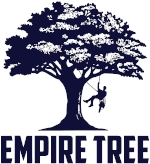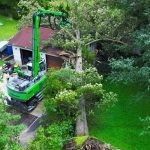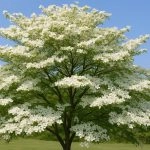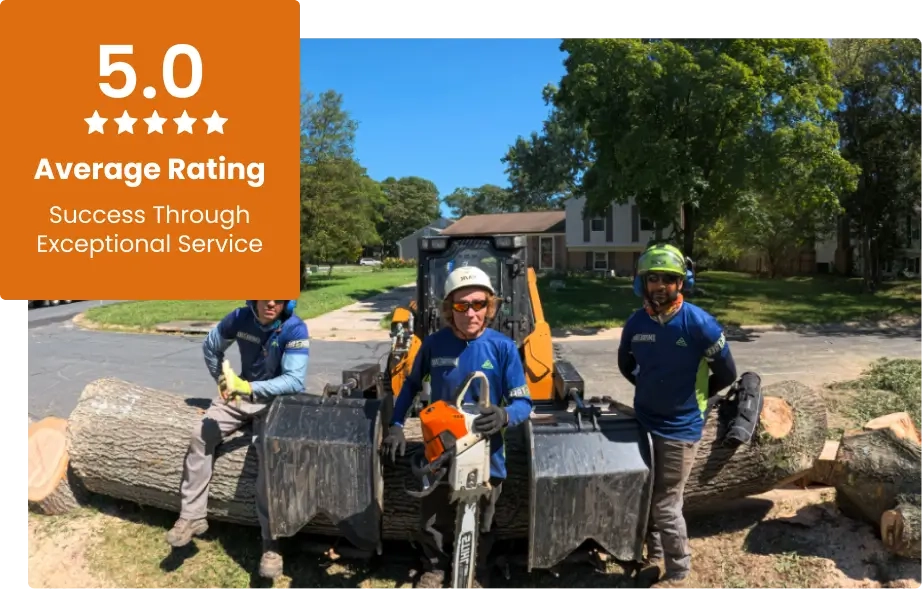- Services
- About Us
- Service Area
- Gallery
- Testimonials
- Blog
- Contact Us
- Critical Area Permit
October 24, 2025
When a large, old tree is finally removed from your property, you probably feel a sense of relief and accomplishment. The job is done, the danger is gone, and your yard looks more open than before. But there’s one last thing left standing: the tree stump.
It might seem harmless. Maybe you think it’ll make a rustic plant stand or just decay on its own over time. But the truth is, a tree stump is far more than just a leftover piece of wood. It’s a growing liability that can negatively impact your family’s safety, the health of your landscape, and even your property’s value. In fact, understanding why you shouldn’t leave a tree stump in your yard is one of the most important lessons for any homeowner.
Leaving a stump behind is like leaving a job half-finished. You’ve addressed the main problem (the tree), but you’ve left a series of new, and often more insidious, problems to develop. From becoming a dangerous tripping hazard to hosting destructive pests and diseases, the risks of keeping a stump far outweigh any perceived benefits.
It’s More Than an Eyesore: The Primary Problems of a Tree Stump
The most obvious issue with a tree stump is that it’s simply unsightly. A decaying, graying block of wood in the middle of a vibrant green lawn is a visual distraction that can disrupt the entire aesthetic of your yard. But the cosmetic issue is only the tip of the iceberg. The most significant problems are the ones you don’t immediately see.
A Breeding Ground for Pests and Insects
This is perhaps one of the most critical tree stump problems a homeowner can face. A rotting tree stump is the perfect habitat for a wide range of destructive insects and pests. As the wood begins to decay, it becomes soft, moist, and a prime location for these creatures to nest and breed.
- Termites: A stump is an all-you-can-eat buffet for termites. Once they’ve established a colony, it’s only a matter of time before they start looking for their next meal—which could very well be the wooden structure of your home.
- Carpenter Ants: Unlike termites, carpenter ants don’t eat wood, but they do tunnel through it to create their nests. A rotting stump is an ideal starting point for a colony, which can then migrate and cause significant damage to your home’s wooden framework.
- Beetles: Various wood-boring beetles can also infest a decaying stump. These pests can spread to other parts of your property, causing damage to fences, decks, and even the structural beams of your house.
Simply put, leaving a stump in your yard is like putting out a “vacant” sign for pests. It’s an open invitation that can lead to costly and extensive home repairs down the road.
A Host for Fungi and Tree Diseases
The dangers of leaving a tree stump in your yard aren’t limited to pests. As wood decays, it becomes an ideal host for various fungi and diseases. These can be harmful to other plants and trees in your yard, as the fungi can spread through the soil and root systems.
A common example is the spread of Armillaria fungus, also known as “oak root fungus.” While the stump itself might not seem to be a threat, its decaying roots can become infected. From there, the fungus can spread to the roots of nearby healthy trees and shrubs, eventually killing them. This means that leaving one stump can potentially put your entire landscape at risk.
The Damage to Your Lawn and Landscape
Beyond the immediate safety and pest concerns, a tree stump also creates a number of practical and long-term issues for the rest of your yard. What starts as a simple inconvenience can quickly escalate into a landscaping nightmare.
Hindering Your Mowing and Landscaping Efforts
Imagine trying to mow a perfect, even lawn only to have to repeatedly maneuver around a hard, unyielding stump. Not only does this make the job more difficult and time-consuming, but the stump itself can also damage your equipment. Hitting a stump with a lawnmower blade can dull or break it, leading to expensive repairs. A stump also makes it impossible to achieve a clean, professional-looking cut, leaving a patch of long, uncut grass around it.
Unsightly Sprouts and New Growth
Many tree species, such as Bradford Pears, Maples, and Willows, are incredibly resilient. Even after the trunk has been cut down, the roots can remain alive and continue to push out new growth, or “suckers,” from the base of the stump. These sprouts are messy, unsightly, and require constant pruning. It’s a never-ending cycle of yard work that you thought you had already finished. This continuous new growth is a strong indicator that the root system is still alive and active, continuing to be a presence in your landscape.
The Risk of Spreading Root Systems
Even after the main trunk is gone, the extensive root system of the old tree can remain a problem. As the roots slowly decay, they can leave behind large voids and cause sinkholes in your yard. Worse, if the tree was growing near a sidewalk, driveway, or underground pipes, the roots may still be a risk. They can continue to grow for some time after the tree has been cut, and can crack concrete or even grow into plumbing lines, causing major structural and plumbing issues that will be far more expensive to fix than the initial stump removal.
The Financial and Aesthetic Burden
As we’ve seen, a tree stump is a financial drain and a safety hazard. But it also affects the visual appeal of your home and its potential value on the market.
Lowering Your Home’s Curb Appeal and Property Value
Your yard is often the first thing people see when they look at your home. It creates an initial impression that can either attract or deter potential buyers and guests. A prominent tree stump is, for all intents and purposes, a permanent flaw in your landscape. It signifies neglect or an unfinished project and can significantly lower your home’s curb appeal. In a competitive housing market, this can be a real disadvantage. When people see a stump, they don’t just see a piece of wood; they see a problem that they will have to deal with, and this can be a real turn-off.
The Messy and Difficult DIY Removal Route
Some homeowners might be tempted to tackle tree stump removal themselves. This often involves renting expensive equipment, using harsh chemicals, or engaging in back-breaking, time-consuming labor. The reality is that DIY stump removal is almost always more trouble than it’s worth.
- Chemicals: Using chemical stump removers can be slow, taking months or even years to work, and can be harmful to surrounding plants and pets.
- Physical Labor: Digging out a large stump is an incredibly difficult and physically demanding task. The roots can be extensive and deeply embedded, making it a frustrating and potentially dangerous job.
- Equipment Rental: Renting a stump grinder requires you to learn how to operate heavy machinery, which can be risky for an inexperienced user. Without the right knowledge, you could damage your property or, more importantly, injure yourself.
Ultimately, the hassle and risk of DIY tree stump removal make a strong case for hiring professionals who have the right tools and expertise to get the job done quickly and safely.
The Professional Solution: Stump Grinding and Removal Services
The most effective and efficient way to deal with a tree stump is to have it professionally removed. The industry standard for this is a process called stump grinding.
What is Stump Grinding and How Does It Work?
Stump grinding is the process of using a specialized machine with a rotating cutting wheel to chip away at the stump and its roots, converting them into wood shavings. The grinder works its way through the stump, reducing it to below ground level. This process is highly effective because it removes the entire visible stump and the main root ball, eliminating all the problems we’ve discussed. The resulting wood chips can then be used as mulch or hauled away. The process is quick, clean, and leaves you with a level area that is ready for new grass, plants, or paving.
Frequently Asked Questions About Tree Stumps
How long does it take for a stump to rot away naturally?
The natural decomposition process for a tree stump is extremely slow. It can take anywhere from 10 to 20 years, or even longer, depending on the tree species, climate, and size of the stump. During this time, it remains a hazard and a potential home for pests and disease.
Is it possible for a tree to regrow from a stump?
Yes, absolutely. Many deciduous tree species can regenerate from the stump, especially if they are healthy. This new growth, called suckers, is typically weak, messy, and undesirable, but it is a clear sign that the root system is still very much alive and active.
Is stump grinding the same as stump removal?
The terms are often used interchangeably, but there is a key difference. Stump grinding focuses on grinding the visible stump and the main root ball to below ground level. True stump removal involves completely extracting the entire root system, which can be a much more intensive and invasive process. Stump grinding is the most common and practical solution for most homeowners.
How do I know if my stump has termites?
Signs of termites in a stump include discarded wings, termite droppings (frass) that look like tiny wood-colored pellets, and visible mud tubes or tunnels on the surface of the wood. If you see any of these signs, it’s a strong indication that the stump is a host for a colony that could pose a threat to your home.
Is professional stump removal expensive?
The cost of professional stump removal varies depending on the size and location of the stump. However, when you weigh the cost against the potential expenses of dealing with home repairs from pest infestations, damaged lawnmower blades, or a medical bill from a trip-and-fall accident, professional removal is a wise and cost-effective investment. Many companies, including Empire Tree Services, offer free, no-obligation estimates to give you an accurate price upfront.
Take the Final Step for a Safer, More Beautiful Yard
The lingering tree stump in your yard is a silent threat to your family, your property, and the health of your landscape. It’s an open invitation for pests, a constant hazard, and a source of frustration that can detract from the beauty and value of your home. Instead of hoping it will one day disappear, take the final, decisive step to protect your investment.
By choosing a professional tree service in Southern Maryland like Empire Tree Services, you can have peace of mind knowing that the stump is gone for good. Our tree stump removal services ensure a clean, safe, and beautiful yard. Don’t let a small piece of wood become a massive problem.





